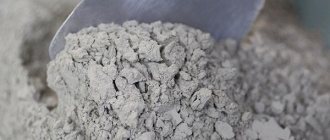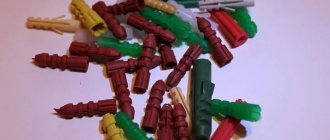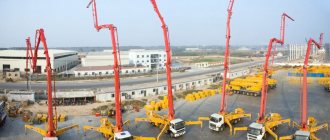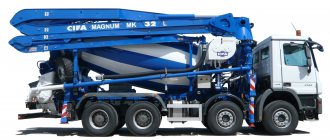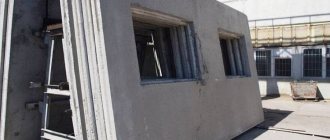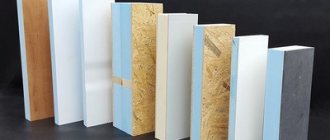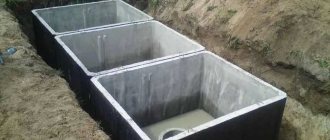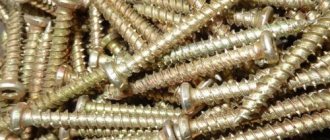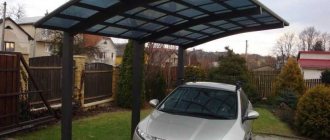During construction work, concrete and cement mortars are mandatory. To transport them and dose them to the desired area of the facility, a special bucket is used, into which concrete is loaded from a concrete mixer or a specialized vehicle. This equipment simplifies the construction process, reduces costs, and makes it possible to save time and money. In ours you can buy a bucket for concrete at the best price on the market. The catalog of the online store presents many types of specialized equipment, which will allow you to choose an option taking into account specific tasks.
Design features and purpose
A container for concrete is a special trough-shaped construction container in which the ingredients for preparing concrete are mixed.
And if there are lifting devices, it is possible to supply the prepared concrete mixture to the mason’s place of work. The design features are small overall dimensions, allowing for the preparation of concrete in the required quantities. Dimensions may vary and depend on the need for concrete composition. Basic dimensions are:
A concrete container or tub is used to perform various tasks. With its help the following is carried out:
- Sealing joints in the foundation of a building.
- Plastering works.
- Carrying out masonry.
- Minor repairs.
- Construction of utility rooms with small overall dimensions.
- Installation of enclosing structures.
Mixing concrete in small quantities can be done by hand using a shovel, trough, dry cement mixture, gravel and water
Products for preparing concrete have a long service life, provided that the inner surface is cleaned of residual cement mortar, which must be removed before hardening. Shape and volume may vary
When thinking about the design of the trough, pay attention to the height of the sides, the small size of which makes it easier to mix concrete
Why is it profitable to buy a concrete bucket from our company?
- A cooperation agreement must be signed with the client, which specifies the duties and responsibilities of the parties, unforeseen and other issues.
- We independently produce tubs for concrete and cement mortar, so the deadlines for fulfilling orders are always respected.
- Each customer receives a warranty for the equipment, under which it is replaced or malfunctions are eliminated.
- Delivery is carried out in Moscow and the Moscow region, to any other region of Russia.
- During the manufacture of products, mandatory technical control is carried out at each production stage, which guarantees the highest quality of the buckets.
- All products have state certificates and comply with GOSTs and building codes.
To buy a concrete bucket at a favorable price from our company, contact our managers by phone, messenger or email. They will help you choose the appropriate equipment option taking into account specific tasks, accept orders and payments, and organize delivery to the desired address. Cooperation with us will enable your business to perform construction tasks much better, which will increase profits and beat your main competitors!
Preparing to make a tub
Container for self-production
If you want to make your own container for supplying concrete, you should give preference to a device in the shape of a glass. The price of such a product is less than a similar one, but shaped like a shoe.
In this case, you need to purchase:
- Rolled products of the required thickness and quality;
- For installation of the structure - special guides;
- Welding apparatus;
- Cutting tools of any type.
A truncated cone is a regular prism, the bases of which have diameters of different sizes.
Instructions for obtaining the workpiece:
Based on the required volume, calculate the parameters of the cone:
Dimensions of a truncated cone
Formula for calculating body dimensions
Having determined the optimal dimensions of the radii of the product, its height is calculated.
- Based on the obtained dimensions, a part template is prepared;
- The template is transferred to a metal sheet.
Making a container
Product drawing
When making a tub yourself, you should remember that the material for the container is constantly exposed to the aggressive effects of the building mixture and moisture. Therefore, it is advisable to choose rolled steel from stainless steel or take into account the thickness of the metal. In this case, the steel grade must be low-carbon, easily weldable.
After transferring the template for the cone blank onto the rolled metal, the part is cut out using a grinder, rolled and welded.
Preparing the cone part
Frame making
In order for the structure to have high strength and reliability, the resulting container must be placed in a frame:
- For its manufacture, you can use reinforcement with a diameter of 10 mm or 12 mm, profile or bent corners and channels.
- A cube is assembled, the bases of which have the form of squares, the side of which corresponds to the upper diameter of the manufactured container.
- The length of the structure is equal to the height of the tub. Additionally, a square is made in the lower plane of the frame, with sides equal to the lower diameter of the cone.
- When installing a cone, elements are used to hold it in the desired position and ensure the rigidity of the entire structure.
- Hinges are welded to the frame to move the product with a crane.
Anyone can find out how a tub for pouring concrete is made by watching the video in this article.
Homemade tub at work
Often, when constructing buildings or other structures, concrete solution needs to be delivered to the construction site and then poured into a special container. For this purpose, a bucket is used to supply concrete.
This will help simplify the construction process. This is especially true when concreting multi-story buildings, when the mixture needs to be raised to great heights or to hard-to-reach places.
Manufacturing
The process of preparing the mortar is a labor-intensive construction operation. That is why the trough for preparing the batch should be highly durable and easy to use.
Let's consider one of the possible design options. For manufacturing you will need the following materials:
a metal sheet. It is advisable to use sheet steel measuring 1000x2000 mm, with a thickness of at least 1 mm, and having a zinc coating. The dimensions of the steel sheet may vary. The main thing is that the volume of the container corresponds to the assigned tasks;
Making a container for preparing a solution from sheet metal
- coniferous wood in the form of boards with a thickness of 30 to 50 millimeters. Prepare one board about 6 meters long, which will allow you to make a trough with dimensions of 1x2 m;
- nails for making a wooden frame or self-tapping screws for fixing steel sheets to boards.
When making a trough for concrete with your own hands, perform the work in the following sequence:
- Cut a solid six-meter board into 4 pieces: two pieces 2 meters long and two 1 meter long.
- Round the edges along the radius on two-meter workpieces, sawing off the corner fragments.
- Nail galvanized steel sheet to the straight parts of the prepared planks using nails.
- Bend the edges of the sheet at the level of the radius part and, using self-tapping screws, fix the meter-long boards.
- Additionally, secure the structural elements with self-tapping screws, which will increase the service life and ensure tightness.
Considering the small overall dimensions and weight, transporting such a container for concrete is not difficult. The radius shape of the sheet at the ends makes it easier to remove the finished solution and clean it. The tightness of the structure is achieved after the initial mixing, when the cement mortar seals small cracks. After the concrete mass hardens, water will not be able to flow out.
After the first batch, the trough will become almost airtight due to the filling of the cracks with concrete mortar
This design option is simple and allows the use of available building materials. Such a trough is a completely complete device for preparing concrete.
Review of the most popular options and their advantages and disadvantages
As noted above, there are mainly two types of structures used, and you need to decide which one is suitable for a particular construction project
They differ in many characteristics, and it is important to choose the best option
Shot glass design
A bucket glass for concrete is one of the simplest types of products, which provides invaluable assistance in the process of work. But you need to understand that products of this type may differ from each other, and choosing a specific option can be difficult, even if you do not buy, but rent the device. After all, productivity and ease of use depend on the right decision.
It was the appearance that determined the name of the glass (some call this type a bell)
Let's consider what criteria you should pay special attention to, whether purchasing new equipment or used units:
The material used to make the product, most often steel, must be very durable. Insufficient thickness does not provide the required reliability
If you choose a used tub, then pay attention to the absence of damage; sometimes eliminating them will cost more than the product itself.
Also check other elements - each unit must be strong and reliable.
If you need a device with a capacity of 1 m3, you should not purchase an option twice as large: it is much heavier, and it will be inconvenient to work with.
A bucket for supplying concrete of this type consists of several main parts:
- The main container, made either simply in the shape of a cone, or as a cone with a cylinder on top. The features of this system depend on the required capacity.
- The support system is also of great importance; it can be of a wide variety of configurations. The main requirement for it is the strength and stability of both empty and full containers.
- A very important part of the design is the shutter with a handle with which the solution is unloaded; the shutter must be durable and the opening handle comfortable. (See also the article Cladding aerated concrete: how to do it.)
A comfortable valve handle is an important part of the design
Eyelets for attaching the structure to the crane and lifting it are very important, since the safety of everyone on the construction site directly depends on it.
Important! Remember that this type of structure is non-rotating, that is, unloading is always done in the same direction. This is convenient when pouring the same type of static structures, but sometimes more precise distribution of the solution is required
Shoe type design
This is a more progressive option, but its price is noticeably higher; the requirements for strength and quality of materials for such structures are similar to those discussed above. (See also the article Concrete crushed stone: features.)
Instructions for checking the product yourself are as follows:
- First, all structural elements are carefully inspected for reliability and absence of damage.
- If the unit is used, then look inside the bunker: if it has not been cleaned, then a layer of hardened concrete can create a lot of problems for you.
Due to its external features, this type of design is called a shoe or galosh
This option has a number of advantages:
- The design of the product is rotary, which allows you to adjust the direction of unloading concrete and increases the ease of use of the bucket. It is this advantage that determines the popularity of this type of product.
- The structure may have a platform for installing a vibrator, which significantly speeds up the unloading process and prevents concrete from sticking to the walls.
- Another undoubted advantage is the ability to load the solution both from a mixer and from a dump truck; this can simplify the work and reduce the cost, since special transport is much more expensive than conventional trucks.
- Despite the large capacity and reliability of the products, their unloaded weight is relatively small, which increases ease of transportation.
- Loading such containers is much easier, since this is done with the tub in a horizontal position (transportation is carried out in a vertical position).
Convenience of loading the container is another important advantage
Renting and purchasing
If you do not want to make a bucket with your own hands, you can purchase or rent it from one of the construction companies. Most often, used equipment with a passport and other documentation is sold or leased to companies that intend to expand: they get rid of their old equipment and purchase new ones. Prices for such devices will depend on how long the owner has been using it. As a rule, after one year of use the cost drops by half. Renting the product is cheaper, but it is better to resort to this method if the tub is needed once. This service is paid daily, prices are adjusted based on delivery conditions, sizes and volumes of the mixture that can be poured inside. When purchasing a device, you should pay attention to the fact that a passport must be attached to it.
Return to contents
Features of the bucket for supplying concrete “Ryumka”
Another option for a bunker is a “shot glass” concrete bucket. It is also called: vertical round (VRK) or non-rotating tub - BN. The container is filled with concrete mixture and transported in a vertical position. It has a tray for directional supply of concrete. The jaw-type valve easily opens the outlet and closes it tightly using a lever. BN is used at sites where there are construction cranes.
The described design options are available in various types depending on the volume of the tub. It varies from 0.5 to 2.5 cubic meters. With an increase in the volume of the bunker, the load capacity increases from 2500 kg to 6000 kg and the dead weight of the product increases from 300 to 1600 kg. An important characteristic of a concrete bucket is the price of the product. It ranges from 20 to 35 thousand rubles, depending on the load-carrying capacity of the structures and the pricing policy of the companies producing these products.
Don’t forget about the possibility of purchasing equipment for rent. Rent of concrete buckets is usually offered by the companies that produce them. Sometimes this makes more sense than buying a bunker. If a device for a concrete mixture is needed for one-time use, then it will be more profitable to pay for its rental than to spend money on buying a tub as personal property.
In any case, a concrete bucket is a necessary element of construction equipment and equipment for the working sector of buildings. This product ensures the transportation of concrete mixtures to any place under construction, extends the time interval for their use, reduces losses of materials due to dosage, maintaining the mixture in working condition and complete unloading using electric vibrators. The choice of the desired bunker model depends on the scale of construction and the equipment of the construction site.
Why is it better to buy concrete containers from us?
It's simple. We will offer you the best conditions. Even if you find similar products at a lower cost, we will still give you a price that you cannot refuse. We know how to attract buyers without losing product quality.
Advantages of IolitM
- The price is from the manufacturer without any surcharges from trade enterprises.
- Discounts – 5% and higher as your order volume increases.
- Many products of our company participate in the “free delivery to the carrier company’s warehouse” promotion.
- Convenient conditions for cooperation! Several payment options, including even credit and installments for regular and wholesale customers. Delivery by your chosen carrier company.
- All products of the IolitM plant are covered by an official guarantee, according to which the buyer receives the right to free repair of our products. Buying containers for concrete is quite simple.
Call right now - and tomorrow we will be able to start producing your order. Meeting deadlines, high quality products and the ability to manufacture any metal structures taking into account individual requirements are available to all our customers.
Types of buckets for concrete
At this point in time, there are three types of buckets for supplying large volumes of concrete to places where it is directly used: “Shoe”, “Wine Glass” and “Mortar Box”. Let's take a closer look at the features of each device.
Rotary device for supplying concrete “Shoe”
The “Shoe” tub is a steel container with variable geometry, containing from 1 to 4 m3 of solution. The body of the container looks like a truncated pyramid, reminiscent of a woman's shoe. On one side of the container there is a rectangular hatch for loading concrete, and in the area of the top of the pyramid there is a hatch for unloading the solution, closed with a special sector shutter.
Main structural elements:
- The body is a welded structure made of sheet steel reinforced with steel channels. To allow movement, the “Shoe” body is equipped with two hinged welded eyes. On the top surface there is a platform for installing a vibrator. The vibrator is used for temporary storage of concrete and for cleaning the container from material residues;
- The shutter consists of two sections hinged. Each section has its own handle, fixed in the non-working position with a special ring. In some Shoe models, the shutter is opened and closed by a steering wheel;
- Section drive;
- Frame.
The “Shoe” is loaded in a horizontal position, and moved and unloaded in a horizontal position by appropriate lifting equipment, usually a tower crane.
Buckets for supplying concrete of the “Glass” design
The “Wine Glass” or “Bell” is a non-rotating, vertically standing structure. This is a bucket for universal-purpose concrete with a capacity of 0.5 to 3 m3 of material.
Main structural elements:
- Frame. It is a welded steel bunker for concrete consisting of a cylindrical and truncated conical part, only a truncated conical part, or a cylindrical and truncated pyramidal part. In this case, the cylindrical part is the loading hatch, and the truncated part of the cone or pyramid is the unloading hatch. In the upper part of the body there is a welded reinforcing ring belt made of a channel or two channels. There are 4 eyes welded along the perimeter of the belt for fastening the slings of the load-lifting device;
- Stand (support). It has a ring shape with 4 posts for welding the body. Made from channels;
- Tray attachment. Serves for supplying concrete to places of use or distribution into intermediate containers.
The main difference between the “Glass” and the “Shoe” is the same loading, transport and working position (vertical).
"Mortar box"
There are three types of configurations for this product: “Scoop Box”, “Boat Box” and “Trough Box”.
- The “scoop box,” depending on the dimensions and thickness of the steel sheet (2, 2.5 or 3 mm), has a capacity of 0.5 to 3 m3 of material. It is a welded rectangular structure, open at the top, reminiscent of a children's scoop. The side walls of the scoop are reinforced with corners, and the top has a reinforcing flange. Along the perimeter of the flange there are 4 welded eyes for movement. At the bottom of the rear wall there are 2 welded eyes for tilting the container;
- The “boat box”, depending on the dimensions and thickness of the steel sheet, has a capacity of 0.25 to 0.5 m3 of material. Structurally, it is a welded trough made of steel sheet made in the form of a truncated pyramid. Following the example of the top of the trough, there is a flange and 4 welded eyes for slinging and moving;
- A “trough box” generally has a capacity of 0.25-0.27 m3 of material. It has the shape of a welded trough with four or two upper welded eyes for movement.
Making your own tub
If desired, you can make such containers for supplying mixtures with your own hands. The easiest to make are concrete buckets in the shape of a shot glass. For production you will only need rolled products of sufficient thickness and quality, guides, a welding machine and any cutting tool.
Preparation of the drawing
When making it yourself and using it at home, it is better to choose a small container volume, about 0.5 m3. That is why there is no need to make the upper cylindrical part of the body, which increases the loading speed of the tub.
A truncated cone, in fact, when the figure is opened, represents a regular prism, at the base of which lie the upper and lower diameters. By calculating the parameters of the cone for a given volume, you can obtain the characteristics of the prism. The resulting part must be transferred to rolled metal.
Cutting the workpiece and welding the structure
When making a tub with your own hands, you need to remember that the metal for the container must withstand the aggressive effects of the building mixture and constant moisture. Therefore, you should choose stainless steel rolled products.
After transferring the drawing to the material, the resulting workpiece is cut out and welded. An ordinary grinder can handle cutting metal, but welding is best done at high temperatures or choose rolled products that lend themselves well to regular welding.
Frame making
The resulting container must be placed in a frame that will strengthen the entire structure. To create it, you can use reinforcement with a rod diameter of 10 or 12 mm. A cube is brewed with bases in the form of squares, the side of which is equal to the upper diameter of the container. The length of the guides corresponds to the height of the tub. In the lower plane of the cube, a square is made, the sides of which are equal to the lower diameter of the cone.
To strengthen the container, guides are welded from the corners of the upper base to the corners of the lower small square on which the cone will rest. After all the elements have been manufactured, the container is welded to the frame, and additional hinges are made for working with the tap.
All construction sites cannot do without concrete mortar. Even wooden buildings require the use of artificial stone when creating a foundation to ensure the reliability and durability of the entire structure.
In addition to transporting the required amount of concrete mixture, it is necessary to unload and supply it to the place of use. A concrete bucket is used for these purposes. The article introduces the types of structures, their features and manufacturing methods.
Purpose
Unloading a container with concrete with a volume of 0.5-1 m3 from a car becomes much more difficult if you cannot drive close to the wooden formwork. Therefore, using a concrete bucket will reduce the cost of delivering the mixture, because if you need to order several cars for construction work, you will have to spend a lot of money. Such a container will allow the solution to be supplied directly to the pouring site. In addition, builders often resort to buckets of different volumes (for example, 0.5-1 m3) in order to store concrete for some time if it could not be poured into the formwork immediately after production.
Return to contents
Design
The concrete pouring bucket should include:
- Loading hopper.
- Shiber.
- Tray.
- Mechanical shutter.
- Control handles.
- Locks (only for rotating models).
- Welded support frame (for fixed models).
- Loops for transportation by overhead or tower crane.
Extra-large capacity tubs, which are produced to individual orders, can be equipped with hanging cradles for workers managing the process of pouring concrete structures.
The standard shapes of buckets for concrete are “shoe” or “galosh” (denotes a rotating structure with a hopper in the form of a truncated cone or pyramid) and “glass” or “bell” (refers to non-rotating products with a vertical loading pattern).
Each of the design options has its own advantages and disadvantages.
In non-rotating models from BN-0.5 to BN-3.0, both vertical and horizontal methods of loading the working mixture are used, using a tray at the bottom of the hopper. At the same time, the conical shape of the bunker is used more often: the capacity of the pyramidal bunker with the same dimensions is slightly higher, but the convenience in manufacturing and subsequent cleaning of the inner surface from concrete residues is much greater. For small buckets, the lower tray is opened manually, but in other cases the drive is provided by a gear jaw shutter. The price of such products starts from 20,000 rubles, when equipped with a cradle - from 26,000 rubles.
The use of buckets for pouring concrete such as a glass and a bell is especially effective for monolithic concreting, since the design involves the use of a concrete pump with a hose.
Rotary buckets for supplying concrete “shoes” are more expensive, but this is where the list of their shortcomings ends. When delivered to the construction site, the “shoe” can be fixed at a certain angle to the supporting surface, which makes work easier: by turning and tilting the bucket, the speed of concrete dispensing from it is adjusted. Since the “shoes” are more universal, the cross-sectional area of the funnel for them is larger.
It should be noted that concrete is loaded into a tub of this type only in a horizontal position. In this case, the process of filling the container can be carried out not only from specialized vehicles, but also from a conventional dump truck. Prices for rotary buckets for concrete of the BP size range - from 38,000 rubles. for a product with a capacity of 1 m3, up to 92,000 rubles. – for products with a capacity of 3 m3.
How does concrete get into formwork?
One of the most critical stages in the construction of monolithic reinforced concrete structures is the delivery of concrete from the mortar-concrete unit to the place of its installation.
How concrete is delivered to the placement site Gone are the days when the concrete mixture was delivered to the construction site by dump trucks; now concrete is transported by domestic and imported concrete trucks of various capacities. Using this delivery method can significantly increase the life of concrete, since throughout the entire trip the mixing drum of the concrete truck rotates slowly (3 - 4 rpm), mixing the mixture, and almost fresh concrete arrives at the site. However, now the concrete mixture delivered to the construction site must be brought into place and poured into the formwork. Two main methods of supplying concrete are used here:• the traditional method: “crane-tub”, in which the concrete delivered to the construction site is poured into a rotating tub, laid in a horizontal position with the shutter closed. A construction crane turns the filled tub into a vertical position, lifts it and carries it to the place where it is poured into the formwork, where the shutter is opened and concrete is poured into the formwork;• a relatively new method of laying concrete using a concrete pump. In this case, the concrete mixture from a concrete truck is poured into the receiving hopper of a mobile (trailer) or truck-mounted concrete pump, which delivers the mixture directly into the formwork through concrete pipes. The power of modern concrete pumps allows the mixture to be supplied to a height of up to 100 m and a distance of up to 300 m. Both of these methods are used on domestic construction sites with equal success, and each of them has its own characteristics and, accordingly, areas of application.
Concrete pumps are high-performance modern equipment for laying concrete. Of course, the use of concrete pumps significantly reduces labor costs during concrete work, but its high productivity (up to 80 m³/hour) makes the use of such equipment economically justified only for significant volumes of concreting. At the same time, a situation may arise when it is necessary to concrete a structure to which the existing crane cannot supply concrete and it is necessary to either rent a crane with a long boom, which has a high lifting capacity with a large reach, in order to supply a bucket of concrete to this place, or use a concrete pump. In such a situation, a truck-mounted concrete pump can be used, which, thanks to a boom reaching a length of 60 m, can in a short time concrete a structure that is inaccessible to a construction crane of medium lifting capacity. For concreting large-area floors, mechanical or hydraulic mobile concrete dispensing booms are used, allowing the mixture to be supplied within a radius of 12 to 40 m from the boom installation point. At the same time, the use of concrete pumps has its own characteristics, in particular, the pumped concrete mixture should not contain aggregates with a fraction larger than 40 mm, in addition, the concrete must have a certain plasticity (cone slump) and it must be supplied continuously, otherwise the concrete pipes must be regularly cleaned of the mixture remaining on their walls. Despite these features, the use of concrete pumps significantly speeds up the process of laying concrete and allows concreting structures of significant volume in a limited time.
Which method should you choose? However, the “crane-tub” method, due to its simplicity and efficiency, is still successfully used on many construction sites, where the bulk of the construction is made up of structures with a relatively small volume, in particular multi-storey and individual residential buildings. For industrial construction or the construction of unique public centers or shopping complexes, it most often turns out to be economically justified to use a concrete pump. In any case, the method of supplying concrete, as well as the equipment and equipment necessary for this, must be selected at the stage of developing a concrete work project, taking into account economic and technological factors.
xn—-ptbbjegddbnkmk.xn--p1ai
Purpose and types of tubs
A concrete bucket looks like a device for storing concrete mortar for a short time. It is used on construction sites and used together with special equipment. It greatly simplifies the work of pouring concrete, quickly supplying large and small volumes of mixtures, performing dosed unloading in the right place.
The tubs differ in design, volume and weight. They are produced in two main types:
- rotary (“glass”);
- vertical non-rotating (“shoe”).
Both options are made from sheet steel, connecting the containers for the solution with welds. To lift the tub to a height, it is necessary to use a truck crane or a gantry crane equipped with a sufficiently long boom. Functionality of this container:
- accelerated process of unloading the working mixture;
- delivery of large volumes of concrete solution to the required pouring points;
- short-term storage period of the concrete composition in a container.
A bucket for supplying concrete should not be confused with drum containers that tend to rotate. The basic design package includes:
- loading hopper for supplying concrete;
- sleeve or tray;
- flap;
- mechanical shutter;
- control handles;
- clamps used only in rotating products;
- welded support frame in vertical type structures;
- mounting loops for transportation by tower or overhead crane.
Glass or bell
This type of design refers to non-rotating models. The “glass” container for pouring concrete has a cylindrical shape with a cone. It delivers concrete vertically. The support system in the form of wide rings at the bottom of the base ensures its stability. Rings may differ in their configuration. This characteristic is typical for an empty container and a filled one.
Loading of the concrete mixture occurs through the top when the working composition is supplied from the dump truck. In this case, the work process is simplified with lowered products. Standard models are equipped with jaw-type locking connections. They are located at the bottom of the cone. For the convenience of supplying the working solution, the following options are also used:
- funnels;
- trailer tray;
- fasteners for flexible hoses.
The “bell” tub is designed for loading concrete into similar and monolithic building structures. They are chosen when working with mixtures of increased rigidity.
Tub in the shape of a shoe
This variety belongs to the rotary type and looks like a structure with varying geometry from 1 to 4 m3. The hole for receiving the composition is distinguished by a rectangular shape. Loading is carried out horizontally, which guarantees stability and easy operation.
Outwardly, it resembles a truncated and tapering pyramid. The unloading funnel is closed with a shutter, just like the “bell” for concrete. The container body is reinforced with metal elements. The ability to be stable and protected from damage is ensured by a special frame.
The “shoe” has a special feature: the vibrator is placed on either side of the container. This characteristic extends the life of concrete if it needs to be stored for a short time. Thanks to this feature, the mixture becomes better and the process of feeding it is simplified with the presence of an appropriate platform.
Another important advantage is the connection of a vibrator. It prevents concrete from remaining on the inside of the container walls. Unloading funnels for “shoes” can be different: from slide to two-section
Control is carried out using a system of levers. Thanks to the shape of the tub, you can prepare concrete right on the site, as well as add the necessary components
Unloading funnels for “shoes” can be different: from slide to two-section. Control is carried out using a system of levers. Thanks to the shape of the tub, you can prepare concrete right on the site, as well as add the necessary components.
Advantages and disadvantages of designs
Each model has its own characteristics, pros and cons. Some fixed-type models use both vertical and horizontal methods of loading concrete. At the bottom of the hopper there is a tray, it is usually made in the shape of a cone. Despite the identical dimensions, the pyramidal container is higher, but it is more difficult to clean the inner surface of solution residues.
In small designs, the bottom tray is most often opened manually. Large containers use locking connections.
Rotary models are more expensive, but also more comfortable to use. When using a “shoe”, supplying the solution requires fixing the structure at the desired angle to the support, this makes the work easier. It is possible to adjust the speed of supply of the mixture from the container. This type of design is more versatile, with increased convenience provided by the large cross-sectional area for the funnel.
Among the disadvantages of the “shoe”, it is worth noting the possibility of loading concrete only in a horizontal plane using two methods - using a dump truck or special vehicles. Thus, the “bell/glass” design is simpler and cheaper, while the “shoe” design is functional and comfortable, but costs more. The first option is suitable for small volumes of work, the second is relevant when performing large-scale fills.
A bucket for supplying concrete is a convenient and functional device that greatly simplifies and speeds up the pouring of concrete at sites. Provided the correct choice and professional operation, the bunker will serve for a long time and faithfully.
Construction tub for concrete mixtures 'Shoe'.
A device for moving bulk cargo is a skimmer. We have come into use with the old word tub, which is really more suitable for the designation of the structure being described.
Portable bunker-tub for mortar concrete mixture.
Construction organizations use more than one type of tub, which differ in design and internal volume.
A description with fragments of personal drawings of the 'Shoe' concrete mix tub is offered in the following description.
The production of the tub (cubel) was based on the documents of GOST 21807-76 in compliance with the specified parameters and recommendations.
The 'Shoe' type bucket for concrete mix is by far the most convenient to use. Its loading opening is made to size for loading directly from a concrete mixer or concrete mixer. The concrete solution is loaded when the tub is in a horizontal position. The shutter is in the closed state at this time. After loading, the tub of mortar is transported by a crane or hoist to the technological process site, where workers use the concrete mortar mixture in doses or all at once.
Description of the design of the portable bunker 'Shoe' for concrete mixture.
The 'Shoe' tub is made in volumes from 0.5m3 to 8m3. You can independently make a tub for any required volume.
Here is an example of our concrete mortar bucket.
The body of the hopper is made of hot-rolled sheet metal 6mm thick from steel grade VSt3ps in accordance with GOST 380. When manufacturing a larger-volume bucket, the wall thickness must be increased. The entire perimeter of the body is reinforced with a metal corner 45x45x5 (VStp3s GOST - 380), which acts as stiffening ribs, and in the lower part of the tub structure, the frame from the corner acts as a mounting platform for the shutter valve. On one of the walls of the tub body there is a platform for a low-voltage electric vibrator.
The shutter valve of the bucket is rotary, segment-type, easily doses the flow of concrete mixture and reliably keeps the concrete solution in the bucket hopper from spontaneous emptying. When the valve moves, it does not jam due to single components of the concrete filler (crushed stone, gravel, slag, expanded clay) getting into the mechanism, since the valve, during closing, slides along the guides of the valve neck and pushes out excess solution and everything that gets into the gap between the valve valve and edge of the bolt neck.
The shutter lever lock is not indicated on the drawings. It can be of any type.
The longer the lever, the lighter, but the less convenient. A short lever is more convenient, but it is difficult to control the bolt mechanism. The control must be made in such a way that the force directed to the lever when closing the bucket shutter does not exceed 6 kgf (60N).
All structural parts of the tub, except for the bunker, are made removable and can be replaced or repaired at any necessary time. Of course, your 'Shoe' tub can be assembled using a welded joint, but I will immediately warn you that equipment sometimes breaks at a construction site. A tub will fall from a certain height. Deformed. What if she comes with a solution? This is where collapsible connections will come in handy. Replace or repair only the damaged part. All costs will be lower.
Like other construction equipment, the tub must be cleaned of mortar after use and the valve and its mechanism must be washed. Inspect externally for cracks, tears and the condition of the lifting hinges.
Let me remind you that the drawings are amateur and made for a personal archive, but at the request addressed to me more than once, I am sharing its fragments with everyone.
Criteria for selecting buckets for supplying concrete
When thoughtfully choosing a concrete bucket, pay attention to several basic parameters. Each of them is important, but much depends on the characteristics, work conditions, and assigned tasks.
The main factors for choosing buckets for concrete mortar:
- Bunker capacity – BN series starts from 0.5 cubic meters, BP series – from 1. Volume gradation is 0.2 cubic meters.
- The thickness of the metal of the tub is an important parameter, especially if the structure is planned to be used for a long time. Thin metal may not withstand a dense mixture and will wear out quickly. It is better to choose a tub made of the thickest possible metal.
- The quality of painting and processing of all surfaces - atmospheric powder paints guarantee the tightness of the coating for at least 12 months in any conditions and the durability of all parts.
- Comfort in operation and transportation - for example, craftsmen advise choosing a “shoe” type design for small volumes of 0.5 cubic meters.
The weight of the tub itself is not always an important parameter, but you need to pay attention to it. Additional options - the presence of a platform for operating the vibrator will be useful (it will be possible to unload concrete faster and reduce the labor intensity of cleaning the bunker inside). The type of mechanism for opening the shutter jaws is important for non-rotating models and affects comfort. The absence of defects is important when purchasing a used tub, and also for identifying manufacturing defects. The presence of sleeves and a pump is important in “bell/glass” type models. The shape of the transport lugs should be as convenient as possible for transporting the tub with cranes/forklifts.
If you are planning a one-time pour or a small amount of work, you can rent a tub, which will be much cheaper
When choosing a rented container, you need to pay attention to the presence/absence of dents, hinge defects, and damage to the coating. When carrying out large volumes of work, craftsmen often use two different types of products at the same time - each tub is installed close to the mold and the machine is more actively unloaded
The “shoe” is relevant for working with bulk materials (crushed stone, sand) when making a cushion for the base. And the funnel of the model is wider than the “shot glasses”.
Criteria for selecting buckets for supplying concrete
When purchasing a new product, pay attention to the following:
- For the desired capacity of the bunker: for buckets of the BN series it starts from 0.5 m3, for buckets of the BP series – from 1 m3. Volume gradation – every 0.2 m3.
- For the thickness of the metal of the bunker: rolled thin sheets will significantly reduce the service life of the product, taking into account the fairly high density of concrete mixtures and the operating conditions of the products at the construction site.
- On the quality of painting of all surfaces: the use of weather-resistant powder paints not only ensures the tightness of the coating in any atmospheric conditions (at least for a year), but also guarantees the durability of the equipment.
- For the presence of additional options in the design of the tub. In particular, the presence of a platform for installing a vibrator (for products such as a bell and a shoe) will speed up the process of unloading concrete and will reduce the complexity of subsequent cleaning of the internal surface of the bunker. For non-rotary versions, the convenience of unloading is also determined by the type of mechanism for opening the shutter jaws.
- Shape of transport eyes. It should be convenient for use when transporting the tub not only with cranes, but also with forklifts.
For periodic concrete work, buckets for pouring concrete are usually not purchased, but rented. The rented container must not have dents on the inner surface of the bunker, damage to the coating or defects in transport loops.
https://www.youtube.com/watch?v=K1qbU2amRPw
Electrofusion welding machine. We weld HDPE pipes
Grab bucket. Steel jaws of special equipment
Some features of the operation of construction devices
As noted above, it does not always make sense to purchase a bucket; sometimes it is much easier to rent one or even use the services of transporting concrete, since doing the work yourself will require too much effort.
This applies to many jobs, for example, cutting reinforced concrete with diamond wheels without special equipment will take too much time and money, and diamond drilling of holes in concrete is a completely impossible task without expensive devices. It is much easier to use the services of professionals who will carry out the work quickly and efficiently.
The paint must be periodically renewed, as the layer is severely damaged during use.

